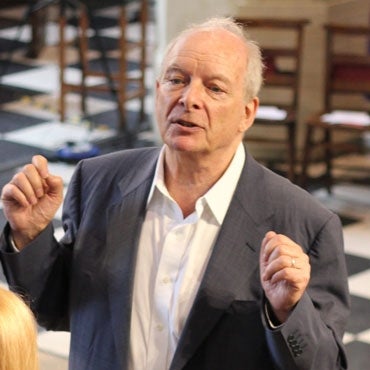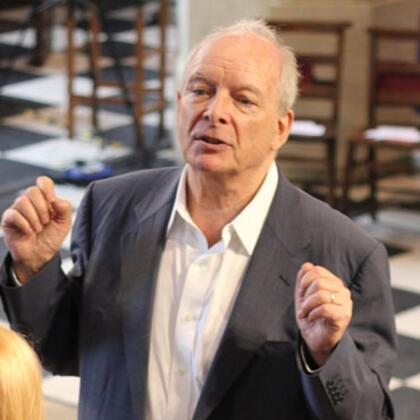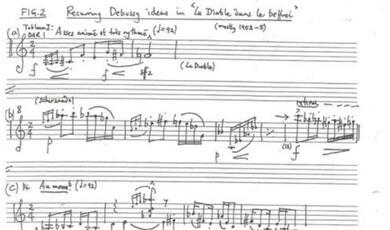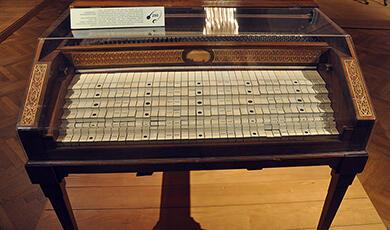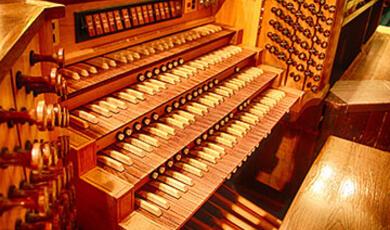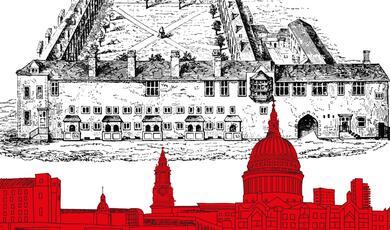St Cecilia and Music: True or false?
Share
- Details
- Text
- Audio
- Downloads
- Extra Reading
Why does music require a 'patron saint'? What are the qualifications of such a person, and how has the praise of a non-musical heroine contributed so much to our poetic and musical heritage: music ranging from Purcell and Handel to Benjamin Britten provides partial evidence, but the social and guild fabric of professional music-making has also benefited from the long-standing Annual Feasts.
Download Text
Gresham Lecture, 22 November 2010
St Cecilia and Music:
True of False?
Professor Christopher Hogwood CBE
Today is St Cecilia’s Day. If you bought the Times this morning, it will tell you in “Saint of the Day”, “The Feast Day of St Cecilia today, patron saint of musicians, has been celebrated since the 4th Century.” And then: “She vowed to remain a virgin but was made to marry a young patrician named Valerian. He respected her faith and was baptised. However, they were both martyred for their beliefs.” It is a very short description, and if I were a libel lawyer, I would insist that you put in “it is said that” and “possibly”, because when they held the last review of saints during the reign of the previous Pope, a number of the saints were shown to be not exactly provable. St George, I think, was only redeemed because he is our national saint; otherwise, they had very little to produce by way of evidence. With St Cecilia also, a lot of “ifs” began to appear. Her story was supposed to have taken place in Rome, but then they said “or maybe Sicily”. It had a date, and then that was suspended. They then queried this Valerian and whether she was made to marry him. They then queried where the evidence was for the persecution, and certainly they queried extraordinary things like when she was executed by the Roman officials in her bathroom. They had hoped to sort of steam her out, but they had failed, so they chopped off her head, which failed to have effect for three days, in which time she went around distributing her goods to the poor. All that was rather without proof.
But, from the musicians’ point of view, they could not find very much at all except misreadings, and that is because, in the earliest descriptions, in Latin, it says that when she was faced with this rather difficult marriage to somebody whose faith she did not approve of, she sang in her heart to God during the ceremony. Well, I suppose that singing in your heart is musical in a way, but not very audible. And, while the ceremony was being organised, it is said, there was the sound of pipes being played outside, and that is all you have to connect this poor lady to music. So this lingered for a while, and after the fourth or fifth century, people began reorganising these words, and the idea of singing in her heart became singing, and therefore she was a musician. The idea of the pipes sounding outside, which were presumably flutes and similar instruments, became organ pipes. It was not a long step then to having St Cecilia playing the organ and singing, and therefore, what better person to link to the new guilds of musicians who were needing a patron saint, like every trade and profession, and so St Cecilia assumed the role on, unfortunately, very shaky grounds.
She looks wonderful in paintings. You all know the Reynolds painting or the Guido Reni. She is usually portrayed with musical instruments about her, of many sorts. There are several paintings of her playing the portative organ, holding it with the pipes up; she is playing discreetly here, a very ladylike and lightweight instrument to carry around with you. There are one or two Dutch paintings, unfortunately, where she is holding the organ downwards, which everybody knows would cause all the pipes to fall out, but luckily the painter had not been told and so it stays intact.
She was cultivated as just nominally the patron saint of music for quite a long while, but not with very much ceremony or efficiency, until about the fifteenth century, and then the concept of guilds and the status of musicians, the safety of musicians, the insurance, the mutual companionship of the musical trade became a question for most medieval and renaissance performers – you wanted to know where you stood in the scale. So, they began to band together, and in London particularly there was an annual celebration of the feast, normally taken on her day, which is today. This year, I notice that it is taking place two days late – you can go to Westminster Abbey, you can go and have a feast, you can go and hear a newly composed piece for St Cecilia, in two days’ time, on the 24th. But this is part of a long tradition that started back in the seventeenth century.
It took the form of a banquet, plus the performance of an ode, and it was instituted, first of all, by a group that called itself the Society of Gentlemen, Lovers of Music. It proved so successful that it went on for 30 or more years, occasional wars with the Dutch and the French breaking it off, but otherwise it was a regular occurrence. It has been revived fairly recently, and is now held annually, in the aid of the Benevolent Society for Musicians.
In 1692, Peter Motto described this regular feast in the Gentlemen’s Journal. He says: “On that day, or the next when it falls on a Sunday, most of the Lovers of Music, whereof many are persons of the first rank, meet at Stationers’ Hall in London, not through a principle of superstition but to propagate the advancement of that divine science. A splendid entertainment is provided, and before it is always a performance of music by the best voices and hands in town. The words, which are always in the patroness’ praise, are set by some of the greatest masters in town.”
In that particular year, the master in town who provided the music for the St Cecilia Feast was Henry Purcell. Other people, his colleagues, supplied the music for other years. His brother, Daniel Purcell, was responsible a year or two later. Jeremiah Clark, John Eccles, Henry Festing… the list of St Cecilia music is long, extending down to the present day, to Benjamin Britten, for example, and Hubert Parry. Quite a number of pop songs by groups that we may or may not know have decided to mention the name of Cecilia as a connection to the past. But the heyday for music produced for this feast was the baroque period (and its recent revival).
In this particular issue of this journal, Peter Motto goes on to talk about the work that was performed in 1692. He says: “In my first journal, I gave you a large account of the music feast on St Cecilia’s Day, so, to avoid repetitions, I shall only tell you that the last was no ways inferior to the former. The following ode,” and then he prints the words that you have by Brady, on one of your sheets, down the left hand side of the sheet. “The following ode was admirably set to music by Mr Henry Purcell, and performed twice, with universal applause, particularly the second stanza,” that is the stanza beginning “Tis nature’s voice”, which, he says, “was sung with incredible graces by Mr Purcell himself.” He then goes on to say that “although I’m not supposed to tell you who the author of the poem is, I will have to!” It is a very metaphysical poem that Brady is working through, with a number of conceits.
We will come to the verse with the “incredible graces” eventually, but just from the beginning, you can see that he is adopting a stance that is impossible for a composer to follow. He hails Cecilia – this is fine, loud, a fanfare – and then he uses imagery of the British forest coming to life, with descriptions of the trees speaking and similar things. It is a nice idea in poetry, but you can imagine Purcell sitting a little bit puzzled, wondering what it was he had to do to demonstrate trees coming alive. So, very nicely, he sets up, in the first, “Hark, hark” stanza, a nice picture by employing all the instruments he had that relied on wood. You have an introductory ritornello where he demonstrates, first of all, the lute, one hollow shell made from thin wood, a very classical and Greek image of the sounding box. This is followed by a couple of violins, famously made from special woods only available in the Cremona and to the Stradivari and people like that, but very much constructed around a wooden piece. After which enter what he calls, and what Purcell calls, two flutes.
In the early baroque period, the term flute was reserved for what we call the recorder, the block flute or direct flute – you blow directly down it. Only later in the baroque did they come up with the flute as we now know it. Because you blow across it, rather than directly down it, it was known as the traverse flute, the traverse, or very often the German flute. So there is a little ambiguity about which instrument people in this period were talking about. Certainly, for Purcell, whenever he mentioned the flute, he meant the direct flute.
Those are the three instruments that play in the introduction to the first solo number in Purcell’s setting, a rather nice solution (for those who have worked it out) as to how the wood has got up, walked, been shaped and turned into musical instruments.
[Recording plays]
He is professional – he gets the names of the wood types right, because the makers knew perfectly well that the violin was made from fir wood, the tubes of the wind instruments were made from boxwood. That is all very nicely illustrated in the poem.
The next stanza, I think, must have been more problematic to Purcell. The trees have all come alive, which is a perfectly nice concept and probably stolen and rewritten. However you then have this very difficult thing, the voice of nature. That is not the sort of thing that you can portray. It is not a thing you will have seen in paintings. It is an image. It is a vision. It is metaphysical, and as such, the poem is very modern, and a little too modern for the average baroque symbolism. Here is nature’s voice moving through the wood… What can Purcell do?
As you have heard, he has already indulged in a fairly ornamental baroque style – those singers were not singing plain lines in a plain fashion. They were doing a lot of flourishing, a lot of coloratura, a lot of imitative stuff. Nature’s voice cannot be a duet. There is only one. It is a unique creature. As the Journal pointed out, Purcell did create a piece with incredible graces. His was a public who knew the new Italian style that arrived in England with the violinists and the singers from Italy who had begun to extemporise on simple tunes, decking them out with amazing graces. If they had the coloratura to do it, they would run up and down the scales and add trills. This was a thing of complete amazement for the English. They had never heard singing so elaborate, or so apparently free from the need for words. The words act only as a springboard, and after that, the voice goes off - I think that ever since Purcell wrote this piece, it has been a standard number for seeing just how ornamentation and decoration can sustain a piece. There is very little else in this number other than the voice, flying around in different conceits and amplifying the words, turning minor when it becomes miserable, getting warlike, getting amorous – everything is portrayed by a single voice in a type of recitative.
Purcell must have been quite a singer, if he sang it, and there has always been a bit of doubt, because of this question of whether there should be a comma there or not. “It was sung with incredible graces by Mr Purcell himself.” “It was sung, with incredible graces by Mr Purcell himself,” or “It was sung, with incredible graces written by Mr Purcell himself,” because normally the Italians would extemporise them. Here was a man who knew how to write them out and you sang what was written. It has always been thought that the answer was the second interpretation, but unfortunately the piece was published by somebody who had been at the ceremony, and this person printed a title page reading “A song set by Mr Henry Purcell and sung by himself at St Cecilia’s Feast”. That is pretty unambiguous.
Purcell obviously liked the piece and he re-wrote it, transposed it in fact, so that a soprano could sing it. That is the version we shall hear now, because it is the version that occurs in a manuscript collection now owned by Gresham College, in Purcell’s own hand - a big collection of favourite arias set just for voice and bass line, a continuum. You should have a facsimile of it in the back of your handout sheets. There should be the one page, but for those who would like to see the complete manuscript and its contents, that is the book that has everything, owned by the College. It is a wonderful selection. Purcell autographs are quite rare, and to have this one set for soprano, “Tis Nature’s Voice” is also a wonderful example of how baroque one could get, given that you have a sort of untouchable subject.
[Music plays]
I think that if you want a wonderful example of pure baroque, this must be it. It has all the right gestures, the rhetoric. When the words say “move”, the music certainly moves, through several octaves. When it says “rejoice”, the music flourishes, and when it “breathes”, it certainly breathes. All the conventional things are there. There is still the construct with nothing else to hold it together – there are no ostinato basses, only the very simplest of chordal accompaniment. It is all done by the voice, and in spite of the constant little embellishments, which sound more and more bird-like, I always think it very nice that the poet does not once mention birdsong. Purcell just stays on the right side, so that you do not think this is a lady imitating a nightingale. This is a lady full of passion for the words, and captivating the mind with them, but somehow, in the background of course, is the imagery of nature associated with and rivalling the song of birds, a nice baroque reticence that that is never pushed into the foreground.
Baroque in itself is, I think, a term slightly too big for us. We have all got very used to handing it around in every context – paintings, literature, architecture, music. They are very rarely of the same period. You will notice that the baroque in painting anticipates the baroque in architecture, which is a long time before what we would call the baroque in music. They are not simultaneous activities as far as the arts have stolen the term. It is almost too convenient to use because, in music certainly, it covers several generations, and it never sat still, especially when you have composers like Purcell. You can see that it is never going to be a frozen art in any shape or form; it is going to be developing. As a result, what I would like to do today is intersperse the Purcell with the ode to similar (but not the same) words that Handel wrote. Purcell’s was 1692. Handel’s was 1739. So you have got 47 years, which, in those days, equals a lifetime.
The poem that Handel took, which you can see printed against the Brady on your hymn sheets, is by Dryden. He went back before Brady, to an older poem, which he then took and developed in his way, and I would like to put, side by side, some of the solutions that Handel took to the question of imagery and declamation and picture-painting and rhetoric and drama against the ones that Purcell used. It is not a beauty competition. It is not a way of seeing that one was better than the other. However I think it will help us to subdivide in our minds - in our musical minds - the idea of what the baroque was. It is inclined to be taken as a single chapter and we assume that everything falls into the same type of gesture, which is far from true - so we shall demonstrate different intentions and different preferences.
A feature similar to both poems - seen a little further down in the Dryden poem, but also in the “soul of the world” verse in the Brady poem - is this idea of “organising”, the idea that music organises the world out of random atoms. So you have what they describe as “jarring atoms”, a fragmentary world which has to be put into place. Here is Purcell’s version, from the Brady “soul of the world” verse. This is the music inspired by these jarring seeds of matter, and in the end, after they have been jarring and running around and getting slightly out of control, Purcell gradually applies more and more harmony, less and less movement, and at the end you get exactly what the poet is talking about, made up of various parts, one perfect harmony.
[Music plays]
This is a lovely baroque description where nothing goes back on itself; the ideas progress through the poem, word by word, action by action, until you end in the perfect harmony. Notice also the proportion, which is part of the underlying conceit of both of these poems, the idea of the harmonic proportion of the world. The heavenly spheres – whether thought of as real or imaginary measurements - brought everything into harmony; not everything would be alike or of the same shape and size, but everything would be proportionate and balanced in relation to one another. This, as the scientists were beginning to tell the musicians, was the basis of harmony. There were proportions to the intervals – the octave, the fifth, the third, figured bass, which tell you the harmonies, consonance and dissonance. These could all be given a number, which was exciting to baroque composers because they relied on figured bass and harmony to support their musical edifices, as you heard in the solo song. Without harmony holding it up, all those embellishments would be absolutely meaningless.
Dryden starts his poem with exactly the same idea: “From harmony, from heavenly harmony, / this universal frame began, / When Nature underneath a heap of jarring atoms lay, / and could not heave her head”. We are in a completely different world. This is not Handel’s doing; this is Dryden’s doing. We did have nature and her voice wafting through the wood. It was a slightly transparent image I think, to which you could put any type of picture you liked. I think this must be one of the reasons that Handel selected the Dryden poem rather than a more recent poem or having one written for him; Dryden is the perfect dramatist. Handel was, all his life, a man of the theatre. He wanted to see things happening and he wanted you to see things as if they were happening on stage. So nature is not just this disembodied voice. Nature is a poor creature with lots of atoms all standing on her head and she cannot raise herself up. Suddenly, a voice is heard on high, another theatrical entrance, from an angel, saying “Arise!” The atoms start to do this wonderful dance and they put themselves into place, jiggling around until they are transformed from random flashing shapes into one organised whole. It is not quite the “one perfect harmony” that Purcell was offering us, but at least it is one perfect organisation, which I think appealed to the Georgians probably more than “one perfect harmony”. Handel goes at it in an absolutely theatrical way. Again, the text goes right through. There is no coming back to repeat yourself. It continues through the story.
One interesting thing to mention, before we get too carried away with Handel’s power of invention, is the fact that Handel had come across a volume of music the week before he started making his setting of St Cecilia. As ever, he was in a hurry. As ever, he needed a prod. He was a curious composer. He was full of ideas, but he was a German improviser, and in Germany, you improvised by taking a given text, a corral or something, and building on it. Throughout his career, Handel relied, alarmingly, on things he had taken from elsewhere. Whether they were stolen or borrowed is your decision, but he was famous for, as William Boyce said, “taking other people’s pebbles and polishing them into diamonds”. It was a nice form of plagiarism. Some examples were very slight; some were enormous. More than 50% of his oratorio, Israel in Egypt, is not Handel’s original material. Its originality lies in the way it was put together.
I will give you a little sample here. The volume of music that Handel had come across is “Componimenti Musicali”, a rather fabulous collection of keyboard music. There are very few copies in existence. It has a very fine title page, and it was done for the Emperor in Vienna. Handel acquired it a week or so before he began writing St Cecilia, and he takes from this volume approximately ten or perhaps more musical ideas, lifted out as they are and re-absorbed into his own piece. Why did he need to do it? Nobody can say, because he was certainly not short of notions, but he liked to have a starting point.
This volume is by Gottlieb Muffat, the imperial organist. Nobody really knew him. How Handel came by the copy, we are not sure. Here is the beginning of one of the Muffat preludes on the harpsichord.
[Music plays]
You would not think that this could be turned into something with a voice and with a picture behind it, but when you get to the moment where the tenor voice is saying that the atoms began to find their places – “Then cold and hot, and moist and dry, / in order to their stations leap” - Handel obviously thought he had found something valuable. You can imagine him saying, “There are lots of leaps in it. It is jumping around. I will just make it a little bit faster, I will score it for violins, I will write a tenor part in the middle, and here are all the atoms leaping around.” You would have thought it would be easier to invent your own atom music, rather than going to these sort of pains, but not for Handel.
[Music plays]
The scene is immediately theatrical. I do not think it matters where Handel gets the material from. The Muffat keyboard piece was not theatrical. It was simply improvisatory. Handel’s piece is perfect theatre: the voice on high, the jumping atoms declaiming. Handel cannot hold down the visual side of the poem. This becomes interesting when you see the rest of the imagery that is used, both by Purcell and by Handel when they come to present the display of instruments. What happens next, in both poems, is a complete instrumental collection. You have, for example, loud and warlike music.
Brady does not help us here, because he begins his warlike verse saying: “The fief and all the harmony of war”. Well, the fief is a pretty poor instrument for suggesting war, and besides, he was talking about the flute not so long before. So Purcell just steps over him, immediately, and the “fief and all the harmony of war” comprises exactly the instruments you would expect it to.
[Music plays]
Dryden gives the musician more to work with. In Dryden’s stanza, it is the “trumpets’ loud clamour”. Straightaway, we know where we are. The sound “Excites us to arms”; we are part of the military manoeuvre. We are not just observing it. We are in it. Then, showing that he knows exactly what went on with these instruments, he describes “the double, double, double beat”. This is not a misprint. He knew that that was the rhythm of drums going tap-tap-tap-tap, the double, double, double beat of the thundering drum. “Charge, charge, tis too late to retreat” is just a staged war picture.
[Music plays]
Immediately, you are part of it, rather than merely absorbing it. The flute (whether direct or traverse) was a traditionally amorous and therefore miserable instrument, and Purcell does an impressive job, with two recorders sounding as miserable as possible.
What Brady did not notice was that flute rhymes with lute. This is surely obvious. He uses the amorous flute and the guitar – not a very good combination. Dryden is much more to the point with the flute and the lute. He puts them both in his aria. Again, Handel steals. He turns to another page of the Muffat volume, and he finds this little piece.
[Music plays]
He makes it not the beginning of his flute number, but the second phrase. He obviously thinks it is an affecting and amorous melody, but that it could be prefaced by two extra bars. So, this is what the flute and lute have.
[Music plays]
Purcell extends. He was great at extending, but needed a catalyst to encourage him. The violins also have an interesting comparison, as much in the poem as in the realisation. “The Airy violin” was a new instrument, for Purcell. We have already heard it, because it was made from wood. They are “speaking Strings, / to court the cruel Fair, or praise Victorious Kings.” The violin can do almost everything – here it is.
[Music plays]
In the verse beginning “Sharp violins,” Dryden places more importance on this instrument. Immediately, you know where you are. They are not just practical, airy instruments, bending to the player’s will. “Sharp violins proclaim their jealous pangs and desperation, full of frantic indignation”. He has a very clear idea of what the violin is capable of.
[Music playing]
It had almost all the feelings of the verse in the bit the instruments play before the voice comes in. You can hear the desperation in the sharp and frantic instruments. Handel returns us to the theatre, as Dryden does in his poem, and stands in contrast to the rather more distanced, philosophical and intellectual tone of the Brady poem. The latter was, of course, written for a smaller and more intellectual gathering.
So, it had to be bigger, bolder, more dramatic. Handel is perhaps most successful when it comes to the organ, the decisive instrument of the piece. He was known as an organist, and he introduces the one instrument which, in his opinion, can bridge the gap between heaven and earth. This is partly because, when you look at an organ and its pipe work, you can see the measurements of all the pipes, coming down. It is an obvious mathematical sequence that is visible to everybody in church; the length of a pipe affects the note that is sounded, giving it a number and a measurement. This was the harmony of the spheres.
Again, when Handel gives us the organ, his shortcut is stealing. This is his Muffat piece.
[Music plays]
It does not sound like much of an inspiration. It is just a series of harmonies going [sings] one, two, three. However Handel sees that he can have the organ play on one, and have the full orchestra answer on two, three. That gives the picture of an organ coming first.
[Music plays]
That was Handel improvising. He just left the part for himself to play. This seems a very nice solution and a nice orchestration, but it is an aria. The singer has to have something to do. This is where I believe that Handel triumphs in terms of organising and arranging, borrowing and stealing his compositions. As with the atoms, he can insert the principal line and make the borrowed line subsidiary. Here, when the organ and the orchestra have had their say, suddenly, a singer comes in with a wonderful, arching melody, and you can see why all singers loved Handel for his sheer power and invention; this is not borrowed.
[Music plays]
That is Handel’s inspiration. The end of the piece is loud and triumphant in both versions, but I shall just give a little sample of the Dryden ending to show the dramatised version, where he does not do as Brady does and conclude with a sense of harmony, of all things united. Dryden, very typically, takes a much more serious approach to this and perceives the winding up of harmony as, in fact, the end of the world. As a result, you have this wonderful vision of the voice on high summoning you, and the last trumpet, at the moment of dissolution, is when all becomes harmony. He ends with that wonderful tercet after a series of couplets. “The trumpet shall be heard on high, the dead shall live, the living die.” He reserves his best line for last: “And music shall untune the sky.”
[Music plays]
It is wonderful, the theatre of the solo voice, the congregation answering, the trumpets coming in, the shuddering for the last dreadful hour. All extremely theatrical, and concluded with that great line, “the dead shall live, the living die”. That was stolen directly from Muffat.
So we have two completely different views of baroque activity - different solutions, different musical challenges, often the same instruments, the same sorts of voices. The audience may be one generation older for Handel than for Purcell, but showcasing a wonderful range of ways of treating poetry and imagery. Handel’s piece also represents a complete defence of what he is often criticised for, his borrowing mechanism. Indeed, what he does with that borrowing is to take Muffat’s pebbles and polish them into diamonds.
Thank you.
©Professor Christopher Hogwood, Gresham College 2010
Part of:
This event was on Mon, 22 Nov 2010
Support Gresham
Gresham College has offered an outstanding education to the public free of charge for over 400 years. Today, Gresham College plays an important role in fostering a love of learning and a greater understanding of ourselves and the world around us. Your donation will help to widen our reach and to broaden our audience, allowing more people to benefit from a high-quality education from some of the brightest minds.


 Login
Login
